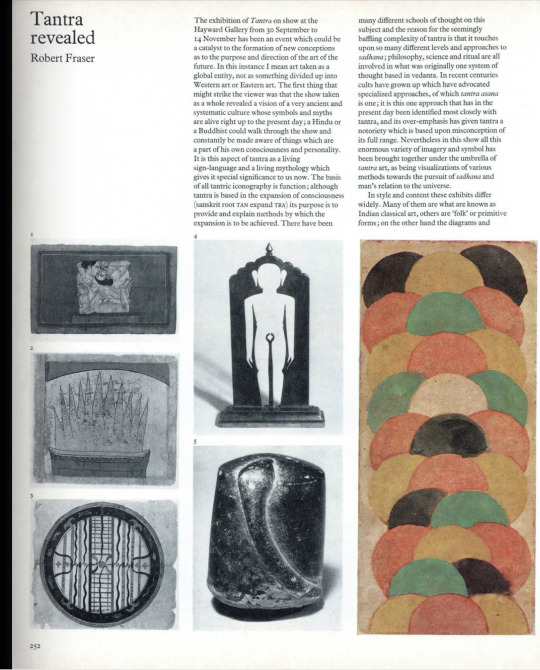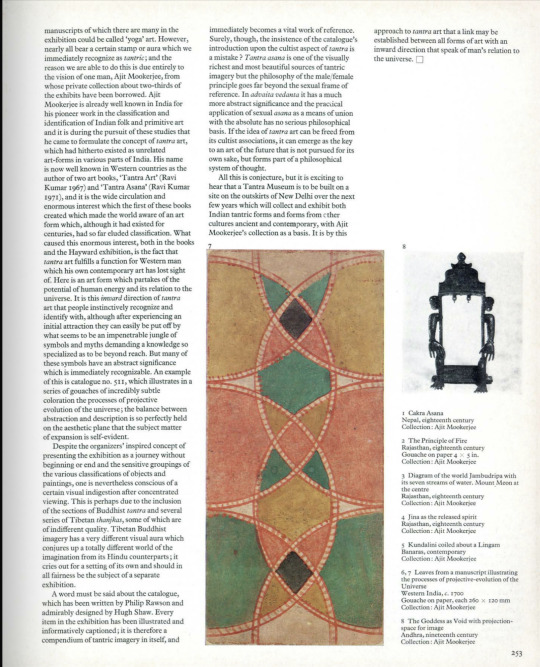#misconceptions and myths about tantra yoga
Explore tagged Tumblr posts
Text
Robert Fraser reviews Tantra Exhibition, 1971 (transcription)
Robert Fraser’s review of The Hayward Gallery’s Tantra exhibition, September 30-Nov. 7, 1971. Published in Studio International, vol. 182 no. 939, Dec. 1971
Originally posted here by @ljblueteak


Transcription below the cut
The exhibition of Tantra on show at the Hayward Gallery from 30 September to 14 November has been an event which could be a catalyst to the formation of new conceptions as to the purpose and direction of the art of the future. In this instance I mean art taken as a global entity, not as something divided up into Western art or Eastern art. The first thing that might strike the view was that the show taken as a whole revealed a vision of a very ancient and systematic culture whose symbols and myths are alive right up to the present day; a Hindu or Buddhist could walk through the show and constantly be made aware of things which are a part of his own consciousness and personality. It is this aspect of tantra as a living sign-language and a living mythology which gives it special significance to us now. The basis of all tantric iconography is function; although tantra is based in the expansion of consciousness (Sanskrit root TAN expand TRA) its purpose is to provide and explain methods by which the expansion is to be achieved. There have been many different schools of thought on this subject and the reason for the seemingly baffling complexity of tantra is that it touches upon so many different levels and approaches to sadhana; philosophy, science and ritual are all involved in what was originally one system of thought based in vedanta. In recent centuries cults have grown up which have advocated specialized approaches, of which tantra asana is one; it is this one approach that has in the present day been identified most closely with tantra, and its over-emphasis has given tantra a notoriety which is based upon misconception of its full range. Nevertheless in this show all this enormous variety of imagery and symbol has been brought together under the umbrella of tantra art, as being visualizations of various methods towards the pursuit of sadhana and man's relation to the universe.
In style and content these exhibits differ widely. Many of them are what are known as Indian classical art, others are 'folk' or primitive forms; on the other hand the diagrams and manuscripts of which there are many in the exhibition could be called 'yoga' art. However, nearly all bear a certain stamp or aura which we immediately recognize as tantric; and the reason we are able to do this is due entirely to the vision of one man, Ajit Mookerjee, from whose private collection about two-thirds of the exhibits have been borrowed. Ajit Mookerjee is already well known in India for his pioneer work in the classification and identification of Indian folk and primitive art and it is during the pursuit of these studies that he came to formulate the concept of tantra art, which had hitherto existed as unrelated art-forms in various parts of India. His name is now well known in Western countries as the author of two art books, "Tantra Art' (Ravi Kumar 1967) and 'Tantra Asana' (Ravi Kumar1971), and it is the wide circulation and enormous interest which the first of these books created which made the world aware of an art form which, although it had existed for centuries, had so far eluded classification. What caused this enormous interest, both in the books and the Hayward exhibition, is the fact that tantra art fulfills a function for Western man which his own contemporary art has lost sight of. Here is an art form which partakes of the potential of human energy and its relation to the universe. It is this inward direction of tantra art that people instinctively recognize and identify with, although after experiencing an initial attraction they can easily be put off by what seems to be an impenetrable jungle of symbols and myths demanding a knowledge so specialized as to be beyond reach. But many of these symbols have an abstract significance which is immediately recognizable. An example of this is catalogue no. 511, which illustrates in a series of gouaches of incredibly subtle coloration the processes of projective evolution of the universe; the balance between abstraction and description is so perfectly held on the aesthetic plane that the subject matter of expansion is self-evident.
Despite the organizers' inspired concept of presenting the exhibition as a journey without beginning or end and the sensitive groupings of the various classifications of objects and paintings, one is nevertheless conscious of a certain visual indigestion after concentrated viewing. This is perhaps due to the inclusion of the sections of Buddhist tantra and several series of Tibetan thanjkas, some of which are of indifferent quality. Tibetan Buddhist imagery has a very different visual aura which conjures up a totally different world of the imagination from its Hindu counterparts: it cries out for a setting of its own and should in all fairness be the subject of a separate exhibition.
A word must be said about the catalogue, which has been written by Philip Rawson and admirably designed by Hugh Shaw. Every item in the exhibition has been illustrated and informatively captioned; it is therefore a compendium of tantric imagery in itself, and immediately becomes a vital work of reference. Surely, though, the insistence of the catalogue's introduction upon the cultist aspect of tantra is a mistake? Tantra asana is one of the visually richest and most beautiful sources of tantric imagery but the philosophy of the male/female principle goes far beyond the sexual frame of reference. In advaita vedanta it has a much more abstract significance and the practical application of sexual asana as a means of union with the absolute has no serious philosophical basis. If the idea of tantra art can be freed from its cultist associations, it can emerge as the key to an art of the future that is not pursued for its own sake, but forms part of a philosophical system or thought.
All this is conjecture, but it is exciting to hear that a Tantra Museum is to be built on a site on the outskirts of New Delhi over the next few years which will collect and exhibit both Indian tantric forms and forms from other cultures ancient and contemporary, with Ajit Mookerjee's collection as a basis. It is by this approach to tantra art that a link may be established between all forms of art with an inward direction that speak of man's relation to the universe.
****
Interesting that Fraser was based in India at this time but familiar enough with a London show to be able to write a detailed review.
Vyner says: "Characteristically, though, his reappearances in London during the four or five years he was away shed little light on his actions and whereabouts other than conveying his increased enthusiasm for all things Indian."
4 notes
·
View notes
Text
Debunking 13 Common Misconceptions and Myths about Tantra Yoga
#tantrayoga #tantra #yoga #meditation #mindfulness #spirituality #chakras #pranayama #asana #consciousness #awakening #energy #selflove #selfawareness #transformation #meditation #chakras #mantras #spirituality #mindfulness #energy #consciousness
Debunking Common Misconceptions and Myths about Tantra Yoga Tantra Yoga is an ancient spiritual practice that originated in India thousands of years ago. It is a complex system of beliefs, practices, and rituals that have been widely misunderstood and misrepresented in other cultures around the globe. Tantra Yoga is often associated with sex, indulgence, and hedonism, but these stereotypes are…

View On WordPress
#debunking common misconceptions and myths about tantra yoga#misconceptions and myths about tantra yoga#tantra yoga is a cult or a secret society#tantra yoga is all about sex#tantra yoga is only for couples
1 note
·
View note
Text
Series 2-10 How we conduct the Layman’s Guide to mindfulness program/course
Series 1-10- Layman’s guide to Relaxation, Resilience, and Mindfulness

Talk on the principles of eastern wisdom
The manuals of eastern wisdom and science are different, but they both aim at the discovery of the truth. The eastern wisdom aims at the discovery of our true nature, and science aims at the true nature of the material world.
The interactive talk helps you understand the cause of stress and suffering as it integrates principles of science and the eastern wisdom.
Five stages of transformation
There are more than 3000 teachers of the eastern wisdom, who followed the same principles to bring an end to suffering.
You will learn and educate about the workings of brain, mind, and consciousness. Learning continues until awakening takes place.
A brief explanation of steps and how to practice:
We explain all the steps before the guided practice. The practice helps the mind, grasp the basic concept and philosophy, and apply during the guided practice for the best results.
Not a single size fits all – we customize and change the practice in every session:
We will personalize the practice, based on the subjective experiences of the group. The program is the most important part of training one’s mind in mindfulness.
Sharing of experiences, questions, and answers:
It is equally important for students treading the path to share their experiences. The program will help in removing many myths and misconceptions. The simple tips to remove obstacles on the path speed up the progress.
Home practice:
We will explain in steps, how to do practice at home. The private students will receive an audio file of the practice.
An invitation to celebrate
Make your life a celebration of peace and happiness. We invite you to write to us at [email protected] for Free Consultation for 15 minutes online.
learn more about programs and courses
online on Google hangouts or skype / in person / private session Email support:
Everyone will receive email support. We encourage keeping a notebook and writing experiences after every practice. Later, send summary by email for further guidance. (Every student can send one mail every week. The email support is restricted to talk, practices and sharing your experiences. )
The people who register as private students receive email/ phone/ hangout support. Also, they self-evaluate (non-medical) themselves with many self-assessment tools and receive personalized practices of every session in digital format.
About the Guide and mentor
40+ years of experience in teaching, research, educating thousands of people includes diplomats, engineers, doctors, kids, professors. Many Himalayan masters have mentored Girish Jha. He studied psychology, philosophy, applied mindfulness, Tantra, Yoga, Spirituality. He has masters in science and applied mindfulness.
He has helped people overcome the challenges of HIV, Substance Abuse, Opioid addiction, Stress, anxiety, ADD, ADHD, depression, relationship problems.
Know more about Girish Jha
0 notes